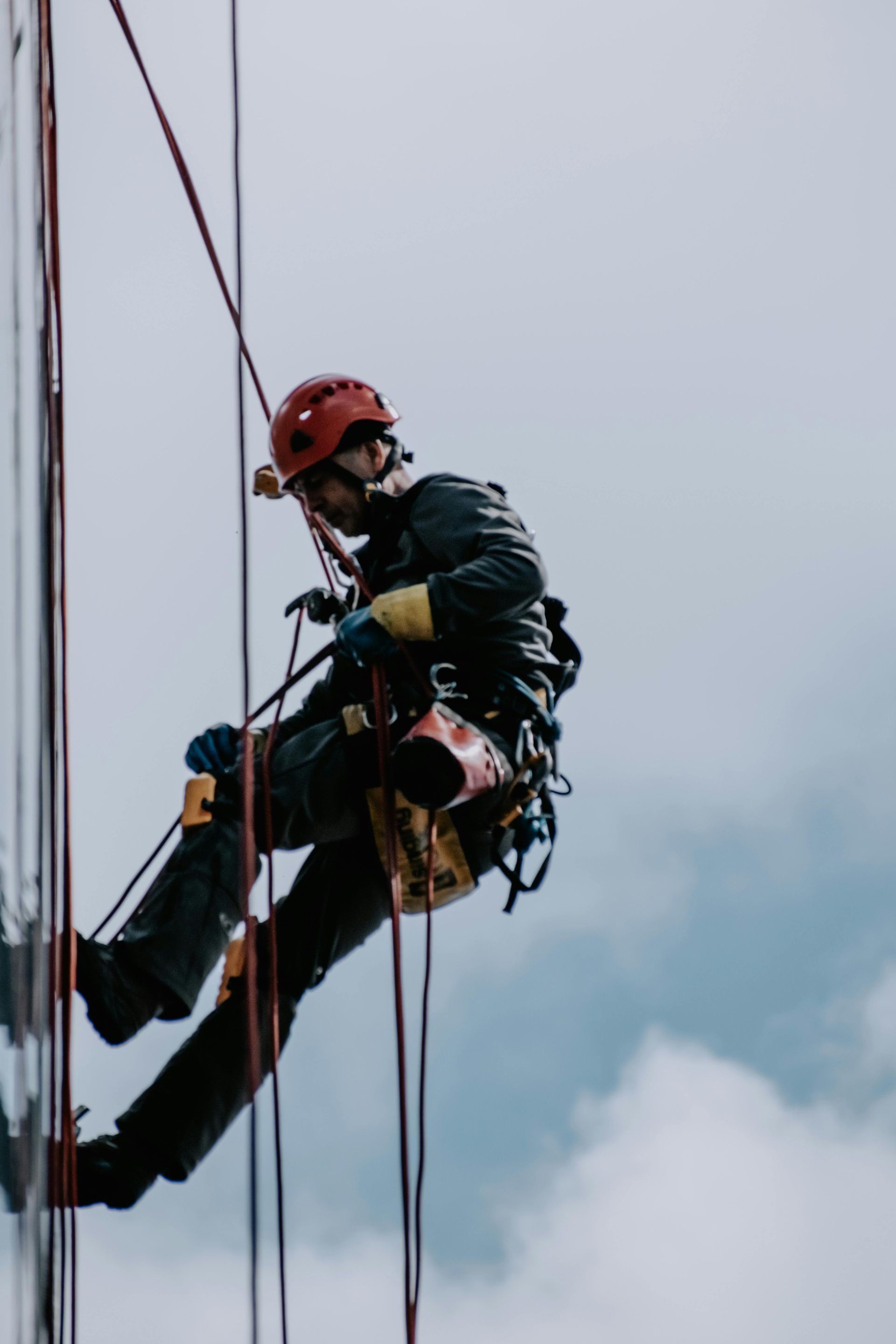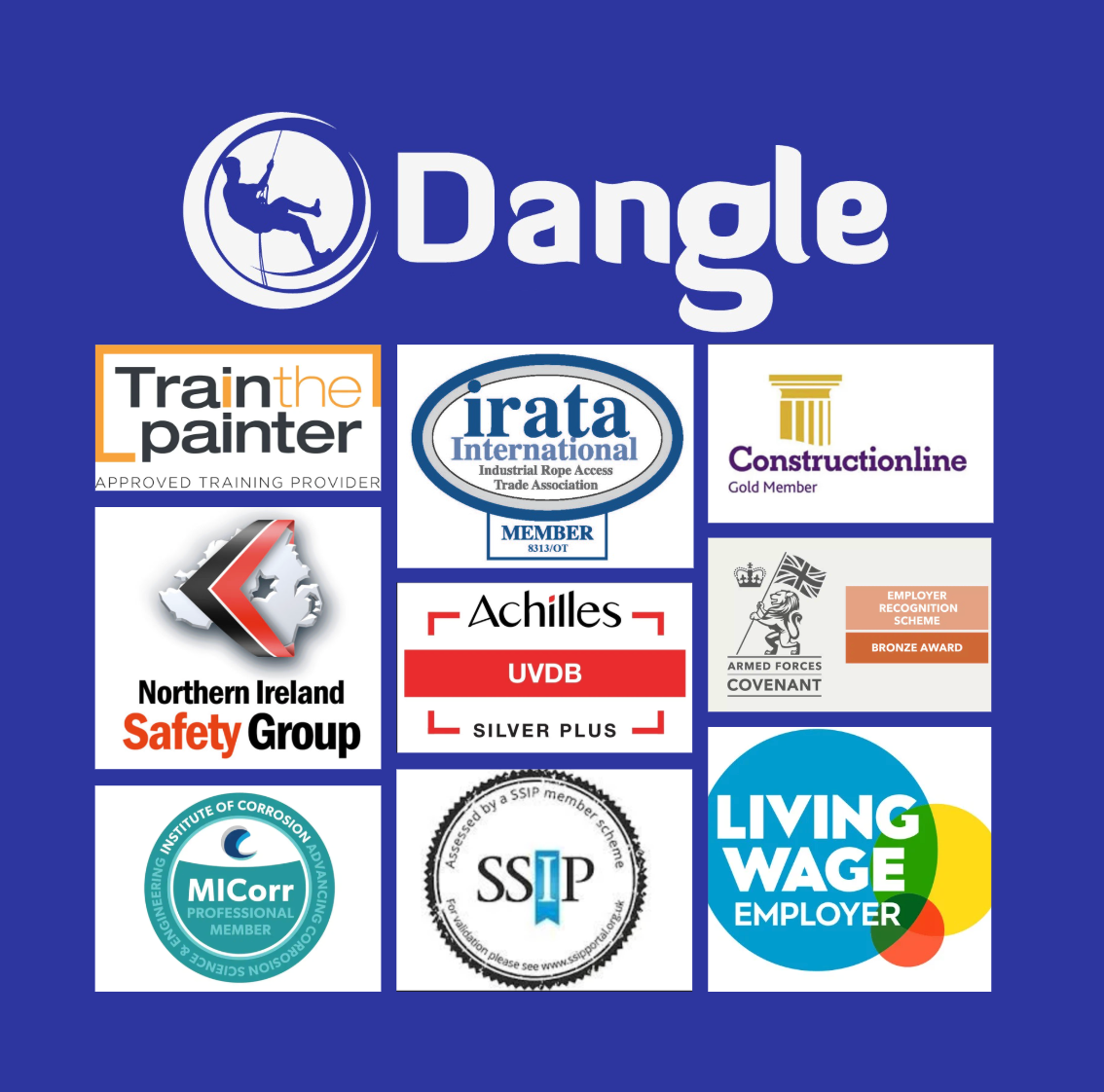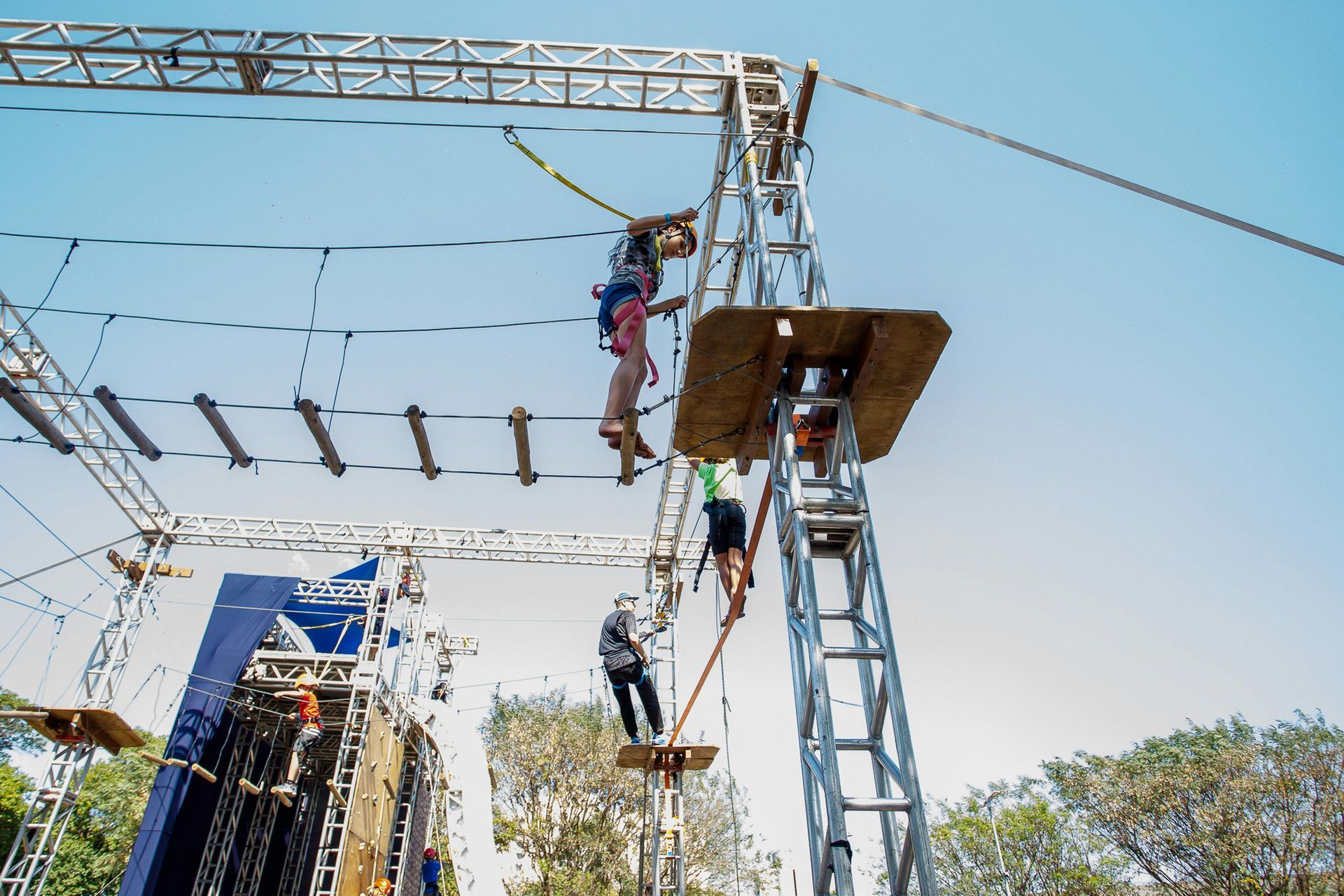Industrial Climbing

Industrial Climbing: The Backbone of Modern Access Solutions
In an age where industries operate at towering heights and complex infrastructure sprawls across challenging terrain, the demand for safe, efficient, and cost-effective access solutions has never been greater. At the heart of these high-stakes operations lies industrial climbing—a discipline that combines advanced rope access techniques with rigorous safety protocols and specialised working at height training.
In this blog post, we’ll explore what industrial climbing entails, the industries it serves, its advantages over traditional access methods, and the future of this dynamic field. Whether you’re an aspiring rope access technician, an industry professional, or simply curious about this fascinating discipline, this guide provides a comprehensive overview of industrial climbing and its critical role in modern industry.
What is Industrial Climbing?
Industrial climbing refers to the professional use of climbing techniques and equipment to access hard-to-reach areas in industrial, construction, and maintenance environments. Unlike recreational climbing, industrial climbing is task-oriented and governed by strict health and safety standards. It involves using ropes, harnesses, ascenders, and other specialist gear to work safely at height.
Often synonymous with rope access, industrial climbing is regulated in the UK by organisations such as:
- IRATA (Industrial Rope Access Trade Association)
- SPRAT (Society of Professional Rope Access Technicians)
- HSE (Health and Safety Executive in the United Kingdom and Northern Ireland)
These bodies set the standards for training, certification, and safe working practices.
Industrial Climbing in Different Sectors
Industrial climbing is an essential service across numerous industries. Here are some of the most prominent sectors that rely heavily on rope-based access systems:
Wind Energy
Wind turbines, both onshore and offshore, require regular inspection, wind turbine maintenance, and repair. Industrial climbers access turbine blades, nacelles, and towers without the need for scaffolding or cranes, reducing downtime and cost.
Oil and Gas
From North Sea oil rigs to offshore platforms worldwide, industrial climbers are called upon to inspect all manner of areas, install equipment, and conduct repairs, including but not limited to painting in high-risk environments above water.
Power and Utilities
Power stations, hydroelectric plants, and transmission towers present unique access challenges. Rope access technicians perform routine maintenance, corrosion control, and inspections at height.
Construction and Infrastructure
Bridges, cofferdams, skyscrapers, and other large structures benefit from industrial climbing for façade work, joint sealing, steelwork inspections, and more.
Telecommunications
Climbers install and service antennas and satellite dishes, whilst also providing lattice tower maintenance, especially in remote or urban environments.
Industrial Painting
Industrial painting often involves treating or coating large steel structures, pipes, tanks, and façades—many of which are located at height or in confined areas. Industrial climbing allows painters to access these difficult-to-reach surfaces quickly and efficiently, enabling tasks such as corrosion protection, fireproofing, and weatherproofing. Rope access techniques reduce setup time, improve quality control, and can significantly lower the project costs.
Benefits of Industrial Climbing over Traditional Access Methods
Industrial climbing offers a range of advantages over traditional access methods such as scaffolding, mobile elevated work platforms (MEWPs), and cranes—especially in environments where space, time, and cost are critical factors.
One of the most significant benefits is speed. Traditional access systems can take days or even weeks to install, particularly scaffolding, which requires extensive planning, transportation, and construction. In contrast, industrial climbers can be on site and operational within hours, allowing for quicker turnaround on inspection, maintenance, or repair work.
Cost-effectiveness is another major advantage. Industrial climbing requires far fewer resources—both in terms of equipment and manpower—than large-scale scaffold builds or heavy machinery. This not only reduces project budgets but also cuts down on operational disruption, which is essential in time-sensitive sectors such as power generation or telecommunications.
Flexibility is where industrial climbing truly excels. Climbers can access nearly any location, whether it’s the underside of a bridge, the blade of a wind turbine, or the face of a high-rise building. Traditional methods often struggle with irregular shapes, confined spaces, or elevated positions that don’t allow for scaffold placement or MEWP access.
Environmental impact and site disruption are also reduced. Scaffolding and heavy plant machinery often require large vehicles, generators, or road closures, which can affect surrounding communities and ecosystems. Rope access, by contrast, leaves a minimal footprint and often goes unnoticed by the public.
Ultimately, industrial climbing delivers a smarter, safer, and more sustainable solution for working at height—enabling technicians to perform complex tasks in challenging environments with unmatched precision and efficiency.
Training and Certification in Industrial Climbing
To become an industrial climber, individuals must undergo rigorous training and obtain certification from recognised bodies. In the UK, the most reputable certifications include:
- IRATA Level 1 – Entry-level certification allowing supervised work
- IRATA Level 2 – Intermediate, with at least one year of experience and a minimum of 1000 hours at Level 1, focusing on advanced skills
- IRATA Level 3 – Supervisory level, requiring at least 2 years extensive experience and 1000 hours at level 2 with a focus on leadership skills
Training typically involves:
- Rope techniques (ascending, descending, changeovers)
- Rescue procedures
- Equipment inspection and maintenance
- Risk assessments and method statements
- Practical and written examinations
- Rigging
Safety Standards in Industrial Climbing
Safety is paramount in industrial climbing. Workers operate in high-risk environments, often in adverse weather or confined spaces. That’s why:
- Daily equipment checks are mandatory
- All operations require thorough risk assessments often called Dynamic Risk Assesment due to ever changing climatic conditions
- Two-rope systems (working rope line and backup rope line) are used as standard
- Rescue plans are in place before work begins
- Technicians must always work under the supervision of a Level 3 IRATA-qualified supervisor
The Health and Safety Executive (HSE) has published guidance on working at height, which is essential reading for any employer or technician.
Tools and Equipment Used in Industrial Climbing
Industrial climbing relies on a variety of specialised equipment, including:
- Harnesses and Lanyards – For fall protection and comfort
- Ropes (Kernmantle) – Static ropes are used to provide reliable support and offer low strech typically not above 5%, however dynamic ropes are typically between 10-15% and fitted to a harness as lanyards (cowstails) to absorb energy in the event of a fall
- Descenders (e.g. Petzl I’D) – For controlled descent
- Ascenders and Foot Loops – To move up ropes efficiently using the correct technique
- Carabiners and Anchors – For connecting equipment and securing positions
- Helmet and PPE – Including chin straps, gloves, eye protection, and steel-toe boots
All equipment must conform to international safety standards (e.g., EN, ISO, and/or ANSI) and be regularly inspected.
Future Trends in Industrial Climbing
The future of industrial climbing is shaped by technological advancement, environmental priorities, and evolving industry needs. As industries continue to innovate, so too does the field of rope access. Here are some of the most exciting trends emerging in the world of industrial climbing:
Drone Integration for Preliminary Inspections
Drones are increasingly being used to carry out visual inspections before sending industrial climbers into the field. This helps reduce unnecessary exposure to risk and speeds up site assessments. Drones can capture high-resolution images and thermal scans of turbines, towers, and building façades. However, they remain complementary—human technicians are still required for hands-on work like maintenance and repairs.
Smart Reporting and Digital Workflows
Modern rope access companies are adopting digital platforms that allow technicians to upload photos, videos, and condition reports from the field in real time. These tools streamline reporting, improve client communication, and create permanent records for asset management. The adoption of cloud-based systems and mobile apps is transforming the way data is collected and shared in industrial climbing.
Advanced Safety Systems and Gear
Manufacturers are constantly innovating to make rope access work safer and more ergonomic. This includes harnesses designed for extended wear, fall arrest systems with automatic locking features, and lightweight carabiners and ascenders. In the coming years, expect to see more integration of wearable technology that can track fatigue, posture, and exposure to environmental risks.
Sustainability and Environmental Awareness
As pressure mounts on industries to reduce their carbon footprint, industrial climbing is increasingly being recognised as a low-impact access method. With minimal equipment and vehicle requirements, rope access generates far less CO₂ compared to scaffold erection or heavy machinery. Companies are incorporating sustainable maintenance as a key metric when choosing access solutions, and industrial climbing fits the bill perfectly.
AI-Powered Maintenance Planning
Artificial intelligence and predictive analytics are being used to forecast when and where maintenance is needed—especially in sectors like wind energy and telecoms. This allows rope access teams to be deployed more strategically, reducing waste and enhancing efficiency. AI tools will continue to refine how rope access services are delivered, improving return on investment (ROI) for asset owners.
FAQ's
Is industrial climbing dangerous?
Like any work at height, it carries risk—but with proper training, equipment, and safety procedures, rope access is statistically one of the safest methods of working at height. IRATA produce an annual Work and Safety Analysis report which represents data submitted by members and provides recommendations to further enhance safety within the industry.
What are the job prospects like?
Excellent. Demand is strong in renewables, telecoms, offshore oil and gas, infrastructure, and more. The Global Wind Organisation (GWO) and Global Wind Energy Council (GWEC) suggest that by 2028, 532,000 technicians will be required worldwide with 40% of roles requiring new entrants to the sector.
Do I need prior climbing experience?
No previous climbing experience is necessary, though being physically fit and comfortable at height helps.
Why Choose Dangle’s Academy?
Here at Dangle, we pride ourselves on offering a wide range of professional and comprehensive inspection, access, coatings, and composite (IACC) industrial services and training courses to cater to the needs of both the private and public sectors. Our dedication to providing high-quality work at height solutions and training has helped us establish a strong reputation in the industry.
With a team of highly skilled and experienced professionals, we are committed to delivering exceptional results that not only meet but exceed our clients' expectations. Our on-site working at height services are designed to minimise maintenance costs in the long and short-term, allowing our clients to save on valuable resources.
Located in Belfast, Northern Ireland, our headquarters serve as the centre of our operations across Ireland. However, we also have a Dangle office based in Scotland, ensuring that we can extend our services to a wider clientele across the United Kingdom. No matter where you are located, our team is always ready to assist you with your industrial maintenance or training needs.
If you would like to learn more about how our dedicated team can help you, we encourage you to get in touch with us today. Our friendly and professional staff are always available to provide you with the information and support you require.


